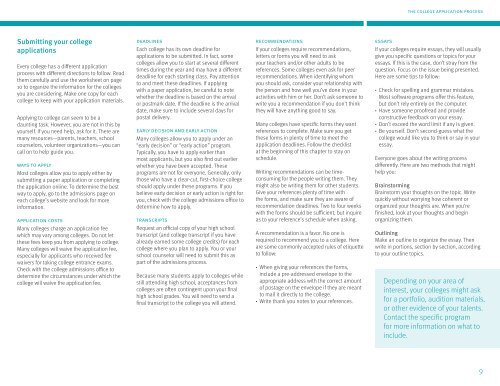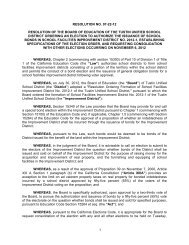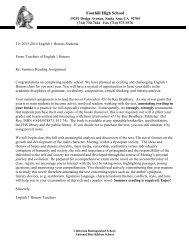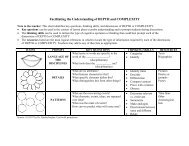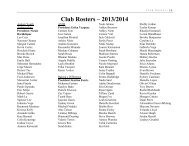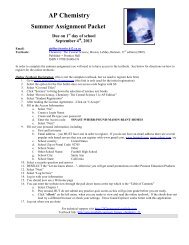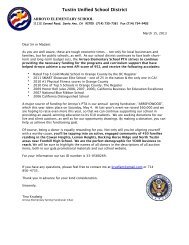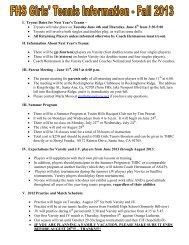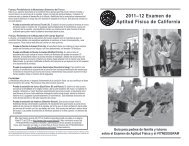College Planning - Tustin Unified School District
College Planning - Tustin Unified School District
College Planning - Tustin Unified School District
Create successful ePaper yourself
Turn your PDF publications into a flip-book with our unique Google optimized e-Paper software.
the college application process<br />
Submitting your college<br />
applications<br />
Every college has a different application<br />
process with different directions to follow. Read<br />
them carefully and use the worksheet on page<br />
10 to organize the information for the colleges<br />
you are considering. Make one copy for each<br />
college to keep with your application materials.<br />
Applying to college can seem to be a<br />
daunting task. However, you are not in this by<br />
yourself. If you need help, ask for it. There are<br />
many resources—parents, teachers, school<br />
counselors, volunteer organizations—you can<br />
call on to help guide you.<br />
ways to apply<br />
Most colleges allow you to apply either by<br />
submitting a paper application or completing<br />
the application online. To determine the best<br />
way to apply, go to the admissions page on<br />
each college’s website and look for more<br />
information.<br />
application costs<br />
Many colleges charge an application fee<br />
which may vary among colleges. Do not let<br />
these fees keep you from applying to college.<br />
Many colleges will waive the application fee,<br />
especially for applicants who received fee<br />
waivers for taking college entrance exams.<br />
Check with the college admissions office to<br />
determine the circumstances under which the<br />
college will waive the application fee.<br />
deadlines<br />
Each college has its own deadline for<br />
applications to be submitted. In fact, some<br />
colleges allow you to start at several different<br />
times during the year and may have a different<br />
deadline for each starting class. Pay attention<br />
to and meet these deadlines. If applying<br />
with a paper application, be careful to note<br />
whether the deadline is based on the arrival<br />
or postmark date. If the deadline is the arrival<br />
date, make sure to include several days for<br />
postal delivery.<br />
early decision and early action<br />
Many colleges allow you to apply under an<br />
“early decision” or “early action” program.<br />
Typically, you have to apply earlier than<br />
most applicants, but you also find out earlier<br />
whether you have been accepted. These<br />
programs are not for everyone. Generally, only<br />
those who have a clear-cut, first-choice college<br />
should apply under these programs. If you<br />
believe early decision or early action is right for<br />
you, check with the college admissions office to<br />
determine how to apply.<br />
transcripts<br />
Request an official copy of your high school<br />
transcript (and college transcript if you have<br />
already earned some college credits) for each<br />
college where you plan to apply. You or your<br />
school counselor will need to submit this as<br />
part of the admissions process.<br />
Because many students apply to colleges while<br />
still attending high school, acceptances from<br />
colleges are often contingent upon your final<br />
high school grades. You will need to send a<br />
final transcript to the college you will attend.<br />
recommendations<br />
If your colleges require recommendations,<br />
letters or forms you will need to ask<br />
your teachers and/or other adults to be<br />
references. Some colleges even ask for peer<br />
recommendations. When identifying whom<br />
you should ask, consider your relationship with<br />
the person and how well you’ve done in your<br />
activities with him or her. Don’t ask someone to<br />
write you a recommendation if you don’t think<br />
they will have anything good to say.<br />
Many colleges have specific forms they want<br />
references to complete. Make sure you get<br />
these forms in plenty of time to meet the<br />
application deadlines. Follow the checklist<br />
at the beginning of this chapter to stay on<br />
schedule.<br />
Writing recommendations can be timeconsuming<br />
for the people writing them. They<br />
might also be writing them for other students.<br />
Give your references plenty of time with<br />
the forms, and make sure they are aware of<br />
recommendation deadlines. Two to four weeks<br />
with the forms should be sufficient, but inquire<br />
as to your reference’s schedule when asking.<br />
A recommendation is a favor. No one is<br />
required to recommend you to a college. Here<br />
are some commonly accepted rules of etiquette<br />
to follow:<br />
··<br />
When giving your references the forms,<br />
include a pre-addressed envelope to the<br />
appropriate address with the correct amount<br />
of postage on the envelope if they are meant<br />
to mail it directly to the college.<br />
··<br />
Write thank you notes to your references.<br />
essays<br />
If your colleges require essays, they will usually<br />
give you specific questions or topics for your<br />
essays. If this is the case, don’t stray from the<br />
question. Focus on the issue being presented.<br />
Here are some tips to follow:<br />
··<br />
Check for spelling and grammar mistakes.<br />
Most software programs offer this feature,<br />
but don’t rely entirely on the computer.<br />
··<br />
Have someone proofread and provide<br />
constructive feedback on your essay.<br />
··<br />
Don’t exceed the word limit if any is given.<br />
··<br />
Be yourself. Don’t second-guess what the<br />
college would like you to think or say in your<br />
essay.<br />
Everyone goes about the writing process<br />
differently. Here are two methods that might<br />
help you:<br />
Brainstorming<br />
Brainstorm your thoughts on the topic. Write<br />
quickly without worrying how coherent or<br />
organized your thoughts are. When you’re<br />
finished, look at your thoughts and begin<br />
organizing them.<br />
Outlining<br />
Make an outline to organize the essay. Then<br />
write in portions, section by section, according<br />
to your outline topics.<br />
Depending on your area of<br />
interest, your colleges might ask<br />
for a portfolio, audition materials,<br />
or other evidence of your talents.<br />
Contact the specific program<br />
for more information on what to<br />
include.<br />
9


